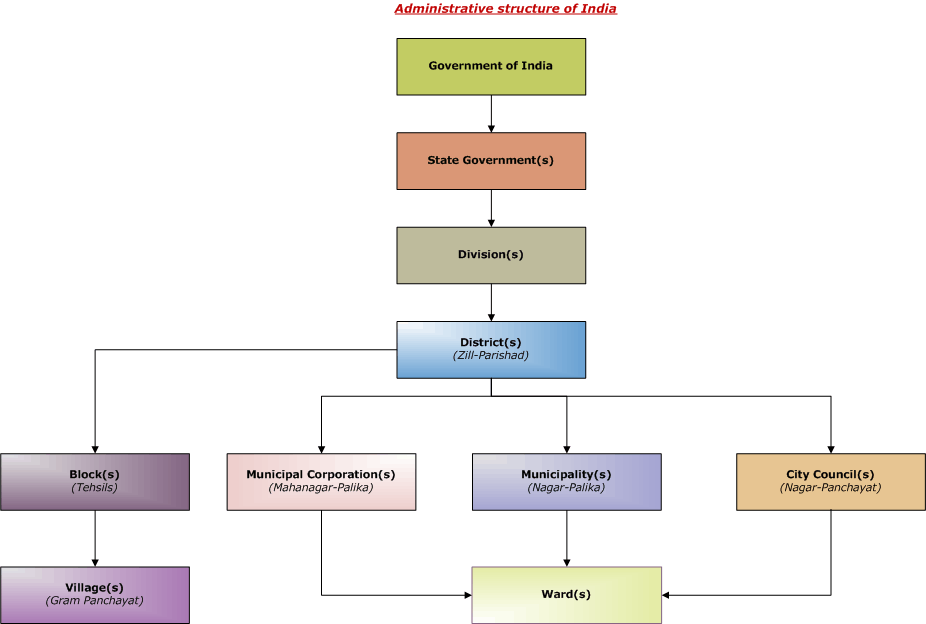Panchayat Samiti (Block)
Republic of India
|
|---|
 |
| This article is part of a series on the politics and government of India |
Judiciary: |
National coalitions: |
|
Local and state govt.
|
|
Panchayat samiti (Hindi: पंचायत समिति) is a local government body at the tehsil (taluka) level in India. It works for the villages of the tehsil that together are called a Development Block. The Panchayat Samiti is the link between the Gram Panchayat (village council) and the zila parishad (district board).[1] There are a number of variations in the name of this institution in the various states. For example, it is known as Mandal Praja Parishad in Andhra Pradesh, Taluka Panchayat in Gujarat, and Mandal Panchayat in Karnataka.
Composition

Typically, a panchayat samiti is composed of ex officio members (all sarpanchas of the panchayat samiti area, the MPs (Rajya Sabha and Lok Sabha) and MLAs (Vidhan Sabha) of the area, and the Sub Divisional Officer of the subdivision), otherwise unrepresented members (representatives of Scheduled Castes and Scheduled Tribes and women), associate members (such as a farmer of the area, a representative of the cooperative societies, and one from the agricultural marketing services sector), and the elected members of that panchayat block (tehsil) on the zila parishad (district board).[2]
The samiti is elected for five years and is headed by a chairman and deputy chairman elected by the members of the panchayat samiti.[2]
- Composition of mandal parishads
A Mandal Parishad is constituted for a revenue Mandal, as such, both the Mandal Parishads and the revenue Mandals are coterminous. A mandal Parishad is composed of the following members:
Mandal Parishad Territorial constituency members. Members of the Legislative Assembly having jurisdiction over the Mandal. Members of the House of people having jurisdiction over the Mandal. Members of the council of States who are voters in the Mandal. One co-opted member, belonging to minorities. The Mandal Parishad Territorial constituency (MPTC) members are directly elected by the voters, whereas, the Mandal President is elected by the MPTC members. The members are elected for a term of five year. The elections to MPTC s is done on political
party basis. The elections are conducted by the State election commission.
The Sarpanches of the Villages in the Mandal are permanent invitees to the Mandal Parishad meetings.
Departments
The most common departments found in a panchayat samiti are:[1]
- Administration
- Finance
- Public works (especially water and roads)
- Agriculture
- Health
- Education
- Social welfare
- Information Technology
Each department in a panchayat samiti has its own officer, most often these are state government employees acting as extension officers, but occasionally in more revenue-rich panchayat samiti, these may be local employees. A government appointed block development officer (BDO) is the supervisor of the extension officers, and executive officer to the panchayat samiti and becomes, in effect, its administrative chief over all operations.[3]
Functions
Panchayat Samiti collects all the prospective plans prepared at Gram Panchayat level and processes them for funding and implementation by evaluating them from the angles of financial constraints, social welfare and area development.It also identifies and prioritize the issues which needs to be addressed at block level.
Sources of income
The income of the panchayat samiti comes from three sources:[4][5][6]
- taxes levied upon land and water usage, professional taxes, liquor taxes and others
- income generating programmes
- grants-in-aid and loans from the State Government and the local zila parishad
- voluntary contributions
For many of the panchayat samiti the main source of income becomes state aid. For others, the traditional taxing function provides the bulk of revenues. Tax revenues are often shared between the gram panchayats and the panchayat samiti.[4][6]
Notes
- ↑ 1.0 1.1 Sarkar, Siuli (2010). "7.3.3 Panchayat Samiti". Public Administration In India. New Delhi: PHI Learning Private Ltd. pp. 178–180. ISBN 978-81-203-3979-8.
- ↑ 2.0 2.1 Singh, Singh Vipul (2010). "Section II Civics: Chapter 8 Rural Local Self-Government". Longman History & Civics ICSE 9. Noida, Uttar Pradesh, India: Dorling Kindersley (India) Private Ltd. p. 265. ISBN 978-81-317-2041-7.
- ↑ Arora, Ramesh Kumar and Goyal, Rajni (1995). "Chapter 17 Panchayat Raj: Struggle For Effectiveness". Indian Public Administration: Institutions and Issues (second ed.). New Delhi: Wishwa Prakashan. pp. 298–300. ISBN 978-81-7328-068-9.
- ↑ 4.0 4.1 Singh 2010, p. 264
- ↑ "Section A Civics: Chapter 7 Local Self-Government". History & Civics IX (eighth ed.). New Delhi: Rachna Sagar Private Ltd. 2011. p. 67. ISBN 978-81-8137-083-9.
- ↑ 6.0 6.1 Madan, G. R. (1990). "Chapter 16 Panchayati Raj". India's Developing Villages (second ed.). New Delhi: Allied Publishers. p. 343. ISBN 978-81-7023-281-0.
| |||||||||||